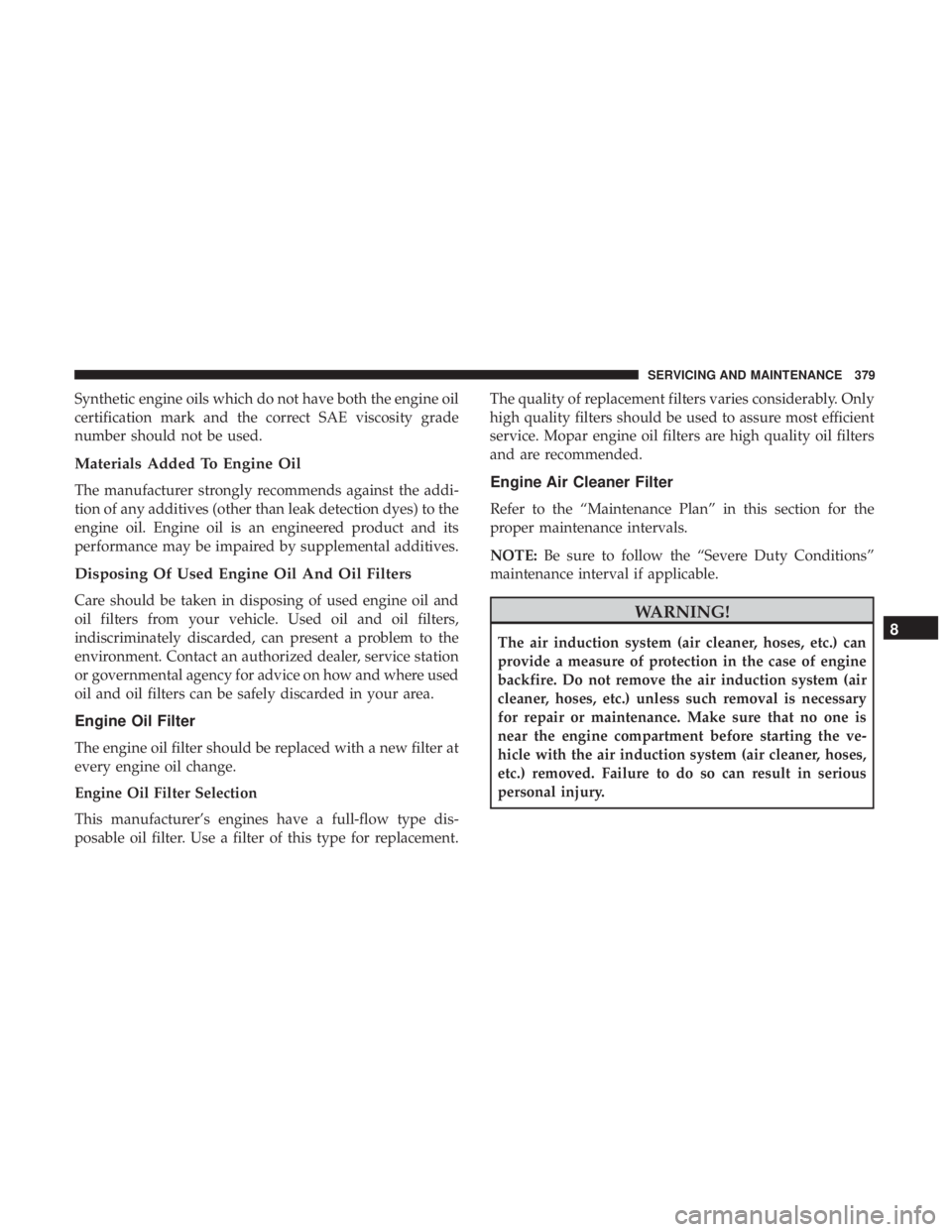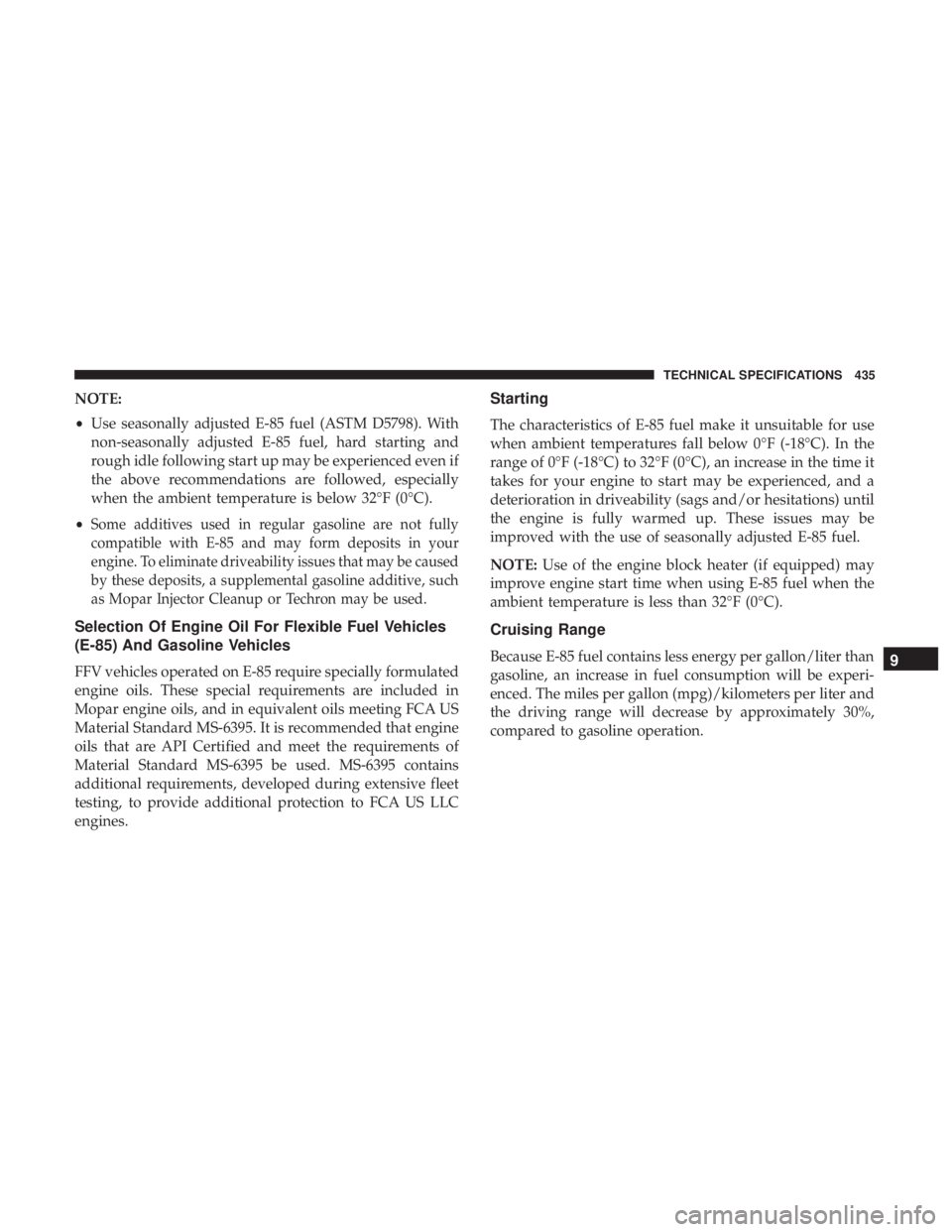Page 381 of 560

Synthetic engine oils which do not have both the engine oil
certification mark and the correct SAE viscosity grade
number should not be used.
Materials Added To Engine Oil
The manufacturer strongly recommends against the addi-
tion of any additives (other than leak detection dyes) to the
engine oil. Engine oil is an engineered product and its
performance may be impaired by supplemental additives.
Disposing Of Used Engine Oil And Oil Filters
Care should be taken in disposing of used engine oil and
oil filters from your vehicle. Used oil and oil filters,
indiscriminately discarded, can present a problem to the
environment. Contact an authorized dealer, service station
or governmental agency for advice on how and where used
oil and oil filters can be safely discarded in your area.
Engine Oil Filter
The engine oil filter should be replaced with a new filter at
every engine oil change.
Engine Oil Filter Selection
This manufacturer’s engines have a full-flow type dis-
posable oil filter. Use a filter of this type for replacement.The quality of replacement filters varies considerably. Only
high quality filters should be used to assure most efficient
service. Mopar engine oil filters are high quality oil filters
and are recommended.
Engine Air Cleaner Filter
Refer to the “Maintenance Plan” in this section for the
proper maintenance intervals.
NOTE:
Be sure to follow the “Severe Duty Conditions”
maintenance interval if applicable.
WARNING!
The air induction system (air cleaner, hoses, etc.) can
provide a measure of protection in the case of engine
backfire. Do not remove the air induction system (air
cleaner, hoses, etc.) unless such removal is necessary
for repair or maintenance. Make sure that no one is
near the engine compartment before starting the ve-
hicle with the air induction system (air cleaner, hoses,
etc.) removed. Failure to do so can result in serious
personal injury.8
SERVICING AND MAINTENANCE 379
Page 437 of 560

NOTE:
•Use seasonally adjusted E-85 fuel (ASTM D5798). With
non-seasonally adjusted E-85 fuel, hard starting and
rough idle following start up may be experienced even if
the above recommendations are followed, especially
when the ambient temperature is below 32°F (0°C).
•
Some additives used in regular gasoline are not fully
compatible with E-85 and may form deposits in your
engine. To eliminate driveability issues that may be caused
by these deposits, a supplemental gasoline additive, such
as Mopar Injector Cleanup or Techron may be used.
Selection Of Engine Oil For Flexible Fuel Vehicles
(E-85) And Gasoline Vehicles
FFV vehicles operated on E-85 require specially formulated
engine oils. These special requirements are included in
Mopar engine oils, and in equivalent oils meeting FCA US
Material Standard MS-6395. It is recommended that engine
oils that are API Certified and meet the requirements of
Material Standard MS-6395 be used. MS-6395 contains
additional requirements, developed during extensive fleet
testing, to provide additional protection to FCA US LLC
engines.
Starting
The characteristics of E-85 fuel make it unsuitable for use
when ambient temperatures fall below 0°F (-18°C). In the
range of 0°F (-18°C) to 32°F (0°C), an increase in the time it
takes for your engine to start may be experienced, and a
deterioration in driveability (sags and/or hesitations) until
the engine is fully warmed up. These issues may be
improved with the use of seasonally adjusted E-85 fuel.
NOTE: Use of the engine block heater (if equipped) may
improve engine start time when using E-85 fuel when the
ambient temperature is less than 32°F (0°C).
Cruising Range
Because E-85 fuel contains less energy per gallon/liter than
gasoline, an increase in fuel consumption will be experi-
enced. The miles per gallon (mpg)/kilometers per liter and
the driving range will decrease by approximately 30%,
compared to gasoline operation.9
TECHNICAL SPECIFICATIONS 435
Page 547 of 560

Flexible Fuel VehiclesCruising Range ......................... .435
Engine Oil ............................ .435
Fuel Requirements ....................... .434
Maintenance ........................... .436
Replacement Parts ....................... .436
Starting .............................. .435
Flooded Engine Starting ..................... .232
Floor Console .............................112
Fluid, Brake .......................... .438, 440
Fluid Capacities ........................... .436
Fluid Leaks .............................. .223
Fluid Level Checks Brake ................................ .393
Cooling System ......................... .389
Engine Oil ............................ .373
Transfer Case .......................... .396
Fluids And Lubricants ...................... .438
Fog Lights ................................70
Fold-Flat Seats .............................43
Folding Rear Seats ..........................46
Forward Collision Warning ....................168
Four-Way Hazard Flasher .....................307
Freeing A Stuck Vehicle ..................... .355Fuel
................................... .429
Additives ............................. .431
Clean Air ............................. .431
Ethanol ........................... .431, 434
Flexible .............................. .434
Gasoline .............................. .429
Materials Added ........................ .431
Methanol ............................. .431
Octane Rating ....................429, 430, 438
Requirements ....................... .429, 436
Specifications .......................... .438
Tank Capacity .......................... .436
Fuses .................................. .315
Garage
Door Opener (HomeLink) ...............105
Gasoline, Clean Air ........................ .431
Gasoline, Reformulated ..................... .431
Gear Ranges ............................. .242
Glass Cleaning ........................... .424
Gross Axle Weight Rating .................291, 293
Gross Vehicle Weight Rating ...............291, 292
GVWR ................................. .291
12
INDEX 545